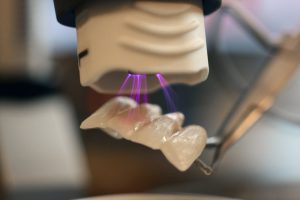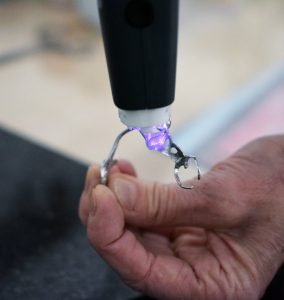Plasma surface treatment technology is well established in many manufacturing industries including medical devices, electronics, and automotive. In dental technology, several use cases have been developed, researched, and established to help dental technicians perform tasks more efficiently and achieve better results for patients. Plasma can initiate several physical and chemical processes that both clean and increase the surface energy of materials, to improve the dental technician’s workflow and the patient’s chances of success. Cold atmospheric plasma technology has multiple dental applications.
Fine cleaning of surfaces before veneering
Natural exposure in air can cause contaminants like oxides, water, organic substances, and dust to settle on the surface of an implant. These contaminants can affect subsequent processes like bonding, coating, and printing.
Plasma can break the organic bonds of heavy organic molecules on the implant’s surface producing lighter and more volatile ones. The reactive chemical species oxidise organic contaminants, forming molecules like carbon oxides and water vapour that evaporate to leave the surface in an ultra-clean state. The process also destroys microbial contamination, sterilising the surface.
This fine cleaning can be useful in applications such as gluing a titanium abutment to a zirconia crown, reducing the chances of poor adherence causing problems or pain for the patient, and the risk the dentist will have to re do them.
Improving bonding during colouration
Even when the surface of an implant is clean, some plastics used in dental applications, such as polymethyl methacrylate (PMMA) commonly used in mouthguards, have a low surface energy, which leads to poor wetting. However, the wettability of a surface is a crucial indicator for the quality of follow up processes.
 If the surface energy of a material is below 50 mJ/m2, it becomes challenging to bond to — the liquid will sit as a round droplet on the surface and lead to weak bonding. In printing applications in dental, such as the colour individualisation of zirconia crowns used to match the colour of the implant to patient’s teeth, plasma can achieve good results. In a traditional process without plasma treatment, after technicians colour the surface of the crown there can be aesthetic issues, such as a conglomeration of pigments at the edge and the glaze/stain not being homogeneous. Plasma treatment avoids these issues.
If the surface energy of a material is below 50 mJ/m2, it becomes challenging to bond to — the liquid will sit as a round droplet on the surface and lead to weak bonding. In printing applications in dental, such as the colour individualisation of zirconia crowns used to match the colour of the implant to patient’s teeth, plasma can achieve good results. In a traditional process without plasma treatment, after technicians colour the surface of the crown there can be aesthetic issues, such as a conglomeration of pigments at the edge and the glaze/stain not being homogeneous. Plasma treatment avoids these issues.
When plasma is in direct contact with the substrate, electric discharges erode it on the micrometre scale, creating anchor group microstructures that can improve the mechanical binding of a stain. Plasma can also deposit polar hydroxyl and nitric oxide groups on the cleaned surface to increase energy and wettability. Plasma treatment can therefore increase the surface energy of the zirconia crown, resulting in better wettability and stronger bonding behaviour. The process is very effective, does not overheat or visually impact the surface and is safe.
As well as improving results, plasma can achieve a time saving for the technician, who would typically require three processes for firing and finishing. Using plasma, this can be reduced to just one process, because plasma helps the crown hold the colours and increases the amount of stain deposited in one go.
What does the research say?
 Much research has been done into the use of plasma treatment in dental technology. Bednarik et al compared cold atmospheric plasma treatment with that of beta radiation for bonding on polypropylene. It found plasma treatment changes wetting behaviour positively, generating polar anchor groups without structural damage. While comparable results could be achieved with beta radiation, the instrumental effort is significantly larger — plasma treatment technology is easy to use and can even be handheld, compared with beta radiation systems which are much larger.
Much research has been done into the use of plasma treatment in dental technology. Bednarik et al compared cold atmospheric plasma treatment with that of beta radiation for bonding on polypropylene. It found plasma treatment changes wetting behaviour positively, generating polar anchor groups without structural damage. While comparable results could be achieved with beta radiation, the instrumental effort is significantly larger — plasma treatment technology is easy to use and can even be handheld, compared with beta radiation systems which are much larger.
For example, the PiezoBrush® PZ3 handheld plasma surface treatment device is the world’s smallest cold atmospheric plasma treatment device. The device is available with two modules: standard, for the treatment of non-conductive materials like plastics, and nearfield, for the treatment of conductive materials like metal. The device is smart and can sense if the incorrect module is being used. The PZ3 is plug and play, requiring only a standard wall socket, no external gas supply, and offering an easy-to-use integrated display. Its low cost means that any dental lab technician can have one on the bench for minimal investment.
Behnecke found positive results in adhesion to polyether ether ketone (PEEK) using the PiezoBrush PZ3. While sanding, low-pressure plasma and atmospheric plasma were tested, the strongest effect on adhesion was found with cold atmospheric plasma. Takao et al studied the healing behaviour of zirconia composite implants in vivo, finding significant better healing behaviour after eight weeks using plasma treatment.
Well established in industrial processes, plasma treatment has several applications in dentistry, which can improve processes for dental technicians and dentists, while improving results for patients.
Contact us if you would like to bring the benefits of the PiezoBrush® PZ3 Handheld Plasma Surface Treatment to your dental lab.
Categories: cleaning, medical, plasma, surface preparation
